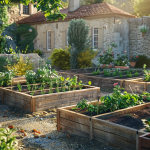Ah, the curious cat – a constant source of companionship and entertainment, with a natural instinct to explore their environment. This innate curiosity can sometimes lead to unexpected problems, especially when it comes to the plants you keep in your home. Cats and plants can coexist, but not all houseplants are safe for your feline friend. Many common plants can be toxic to cats if ingested, causing a range of symptoms from mild discomfort to severe health issues.
The good news? There are plenty of non-toxic, cat-friendly plants that you can incorporate into your home décor. Not only will these plants enhance the aesthetics of your home, but they also offer a multitude of benefits such as purifying the air and boosting your mood. This article will guide you on the best pet-safe houseplants to keep in a home with curious cats, how to care for them, and how to create a cat-friendly green space.
Avez-vous vu cela : How to Introduce a Puppy to a Household with an Alpha Cat?
The Top Pet-Safe Houseplants for Homes with Cats
When you want to bring a bit of nature into your living space, it’s essential to choose plants that are non-toxic to your pets. The following houseplants are not only beautiful but also safe for your curious cats:
Areca Palm: Also known as the Butterfly Palm, the Areca Palm is a favorite among cat owners. Its long, feather-like leaves add a touch of the tropics to any room. It’s also beneficial in removing toxins from the air.
A voir aussi : What’s the Ideal Exercise Plan for a Dog with Early-Stage Hip Dysplasia?
Spider Plant: Spider plants are hardy, easy to care for, and safe for cats. They have long, slender leaves and produce baby ‘spider’ plantlets that dangle from the mother plant.
Boston Fern: This plant is a classic that loves indirect light and high humidity. Its delicate, feathery fronds are non-toxic to cats.
Remember, even though these plants are considered safe, excessive nibbling can still cause mild stomach upset for your cat. It’s best to keep the plants in a place that’s out of reach or train your cat to stay away.
How to Care for Your Pet-Safe Houseplants
Taking care of your houseplants involves more than just watering them. Different plants have different needs, and understanding them will ensure your green friends thrive.
Most houseplants prefer a bright, indirect light source. Too much direct sunlight can scorch the leaves, while too little can stunt growth. Find a spot in your home that receives a good amount of natural light, but not too intense.
Watering frequency depends on the type of plant and its individual needs. Overwatering is a common mistake in plant care, and can lead to root rot. As a rule of thumb, the top inch of soil should be dry to the touch before watering.
In addition to light and water, pay attention to the type of soil your plants need. Some plants prefer well-draining soil, while others thrive in more moisture-retentive mixtures.
Creating a Cat-Friendly Green Space at Home
Creating a green space that’s safe for your cat can be a rewarding endeavor. You can do this by strategically placing safe plants around the house, providing your cat with a stimulating environment that mimics the outdoors.
Consider creating a ‘cat garden’ with a selection of pet-friendly plants. Some cats enjoy nibbling on grass-like plants, so consider adding some non-toxic options like wheatgrass or catnip.
Ensure your plants are stable and not easy to knock over. Cats love to climb, so consider hanging plants or using sturdy plant stands.
Finally, be vigilant about any plant pests. Cats are likely to chase and ingest bugs, so keep an eye out for any unwanted visitors on your plants.
Nurturing a Healthy Relationship Between Your Cat and Your Plants
Introducing new plants into a home with cats requires some thought and preparation. Monitor your cat’s reactions when introducing new plants. If your cat shows too much interest, consider moving the plant to a higher location or using a deterrent like citrus peels or a spray bottle to discourage interest.
While it’s important to have a safe environment for your cat, it’s also crucial to have a happy, healthy cat who feels engaged and stimulated. Houseplants can provide this stimulation, offering new textures and smells for your cat to explore.
Remember, it’s always better to err on the side of caution when it comes to your pet’s safety. Before introducing any new plant into your home, be sure to research its toxicity. It’s always a good idea to consult with your vet if you’re unsure about a particular plant.
Navigating cat ownership and plant parenthood can be tricky, but with careful selection and a bit of planning, you can create a harmonious, green-filled home that’s safe and enjoyable for everyone.
Easy Care Instructions for Your Pet-Safe Houseplants
Caring for your pet-friendly houseplants does not have to be a daunting task. While every plant species has its own specific needs, there are a few generalized tips that can help you keep your green companions in top shape while ensuring they remain safe for your cats.
Bright indirect light is the key requirement for most indoor plants. Position your plants near windows that receive ample natural light but not directly under the sunrays. This prevents the leaves from getting scorched due to direct sunlight.
As for watering, it’s important to remember that more isn’t always better. Overwatering is a common issue that can drown your plants and cause root rot. Instead of sticking to a strict watering schedule, check the top inch of the soil. If it’s dry to the touch, it’s time to water.
In terms of soil, different plants have different preferences. Some plants, such as the Areca palm, prefer well-draining soil while others, like the Spider Plant, need a more moisture-retentive mixture. Always research the specific soil requirements of your houseplants.
Lastly, keep an eye out for pests. Cats are natural hunters and might eat any bugs they find. Regularly inspect your plants for any signs of pests to keep your plants and your cats healthy.
Conclusion: Cultivating a Safe and Green Environment for Your Cats
A home filled with lush, green leaves can be a haven for your cats and a visual delight for you. However, pet owners must remember that not all beautiful plants are safe for our feline friends.
When decorating your home with plants, always pick pet-safe varieties like the Areca Palm, Spider Plant, or Boston Fern. These plants not only enhance the aesthetics of your home but also purify the air, making them perfect for homes with cats and dogs.
While cultivating indoor plants, it’s important to follow the appropriate care instructions. Paying attention to the plant’s needs for light, water, and soil can ensure they thrive. Bright indirect light, proper watering, and the right soil mix can make a world of difference to your plants’ health.
Creating a cat-friendly green space at home requires stability and vigilance. Making sure your plants are secure and free of pests will prevent any accidental toppling over or ingestion of bugs by your curious cats.
Finally, always remember to check a plant’s toxicity before bringing it home. If you’re unsure, it’s best to consult with your vet. It might take a little effort, but by choosing the right plants and providing proper care, you can create a harmonious indoor garden that both you and your cat can enjoy. Happy planting!






